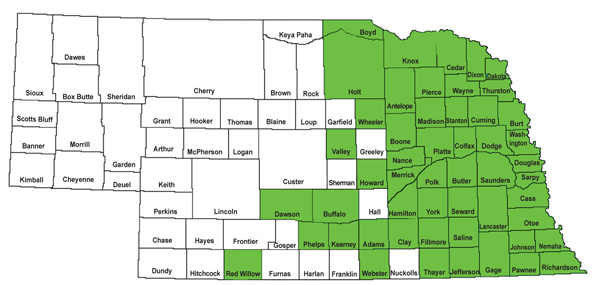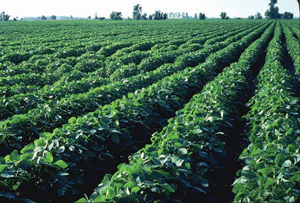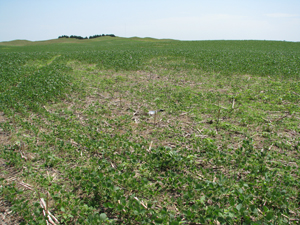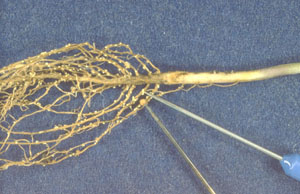G1383
Soybean Cyst Nematode:
Identification and Management
Once established in a field, soybean cyst nematode will continue to increase until appropriate management steps are taken. This NebGuide discusses how to recognize and manage soybean cyst nematode.
Loren J. Giesler, Extension Plant Pathologist
John A. Wilson, Extension Educator
Introduction
Soybean cyst nematode (SCN), Heterodera glycines, is an increasing production problem for Nebraska’s soybean producers. SCN has been confirmed in 52 counties in eastern and central Nebraska (Figure 1). Originally found along the Missouri River, SCN has been identified as far west as Dawson, Phelps, and Red Willow counties in the past few years. However, based on the frequency and level of infestations, it would appear SCN has been present in these areas for a number of years and only recently identified.
Over 136,000 eggs per 100 cc (3.4 oz) of soil have been recorded during surveys of some Nebraska fields. This translates into hundreds of eggs per teaspoon of soil, with each egg capable of hatching and initiating an infection in the roots. Once established in a field, SCN will continue to increase unless proper management actions are taken.
 |
| Figure 1. Nebraska map showing counties with confirmed SCN present as of February, 2011. |
Life Cycle
The SCN life cycle has three main stages, with one cycle being completed in 24 to 30 days. The cycle starts in the spring when temperature and moisture levels become adequate for a nematode egg to hatch. The juvenile emerging from the egg is the infective stage of SCN and will die from starvation if it doesn’t find host plant roots within several days to a week.
Once a juvenile has penetrated the soybean root, it moves through the root to the vascular tissue, where it establishes a feeding site by secreting enzymes. These enzymes modify the root cells and transform them into feeding site cells. The nematode then continues to feed and swell. Eventually the females burst through the root tissue. (These are the tiny, white lemon-shaped bodies found on roots of infected plants.)
Male nematodes migrate out of the root, fertilize the swollen females, and eventually die. The fertilized females produce eggs that fill their entire body cavity. The egg-filled bodies of the dead females are referred to as the cysts.
These cysts eventually dislodge from the roots and are free in the soil. Each cyst can contain up to 400 eggs. Eggs can survive for many years within the protective walls of the cyst until appropriate hatching conditions are present. Generally, hatching is also regulated by some chemical signal from emerging soybean, or other host crop, or some weed roots (Table I).
If an unsuitable host, like corn, is grown that season, the nematode eggs remain dormant in the cyst until soybeans or another host plant is grown again. Several seasons without a host cause some eggs to lose viability because the cysts become infected with bacteria, fungi, and other natural biocontrol agents.
| Table I. Host plants for SCN, including weed hosts, that have had one or more populations of SCN reproduce on them, and nonhost crops. | ||
| Host Crops | Weed Hosts | Nonhost Crops |
| Birdsfoot
Trefoil Edible Beans Clover (Alsike, Crimson, Sweet) Cowpea Lespedezas Lupine (White, Yellow) Soybeans Vetch (Common, Crown, Hairy) |
Common Chickweed Common Mullen Field Pennycress Henbit Pokeweed Purslane Sericea Lespedeza Wild Mustard |
Alfalfa Canola Clover (Red, White, Ladino) Corn Forage Grasses Small Grains (Barley, Oats, Rye, Wheat) Sorghum (Grain, Forage) Sugar Beets |
Symptoms
Field Symptoms. Identifying symptoms of SCN infestation can be difficult. Usually, the first indication of a problem is below-expectation yields. Moderate levels of SCN may not produce any visible, aboveground symptoms, yet yields may be reduced 5 to 10 bu/a or more. The first visual sign of an infestation is usually a slight variation in the height of otherwise healthy-looking, dark-green plants (Figure 2).
 |
 |
|
| Figure 2. A light-to-moderate SCN infestation (left) can cause slight difference in height on otherwise healthy-appearing plants. Yellow, stunted soybean plants (right) are damaged by a severe SCN infestation. These areas are often circular or oval. | ||
Higher SCN levels can cause stunting, chlorosis, and even plant death. Aboveground symptoms can be confused with damage from compaction, nutrient deficiencies, drought stress, low-lying wet areas, herbicide injury, and other plant diseases. Circular- to oval-shaped areas of stunted, yellowed plants can be observed (Figure 2). Areas of SCN injury are often elongated in the direction of tillage practices, since cysts are spread by tillage equipment. Susceptible soybeans grown in SCN-infested soils are slower to reach canopy closure.
Individual Plant Symptoms. Plant symptoms include stunted roots with fewer nitrogen-fixing nodules on the roots. SCN infestations may increase susceptibility to soilborne fungal infections. The only unique symptom or “sign” is the presence of the adult females (also known as cysts) on the roots (Figure 3).
 |
| Figure 3. (A) Adult female SCN on infected soybean root (Courtesy of G. Tylka, Iowa State University); (B) Cysts of varying maturity (dark brown is fully matured cyst); (C) eggs with juvenile nematodes that are released from the eggs. |
|
Adult females appear as lemon-shaped bodies on the roots and are initially cream-colored. They later turn yellow and, finally, tan to brown as they mature. Although these are much smaller than nitrogen nodules, they can be seen with the unaided but trained eye (Figure 4).
Observation of adult females on the roots is one way to confirm an SCN infestation in a field. In most SCN-infested fields in Nebraska, females are evident on roots a month after emergence. However, the absence of females (cysts) on the roots doesn’t mean a field is free of SCN. In fields with a low cyst population, very few females may be found on the roots, and they are easy to miss by visual observation. A better way to determine SCN’s presence in a field is with a thorough soil test.
Soil Sampling for SCN
Soil samples can be collected at any time of the year. Collect 15 to 25 soil cores around the roots (if plants or stubble rows are present) to a depth of 6 to 8 inches and mix the cores in a bucket. Fill a standard soil-sampling bag with the soil mix, store samples in a cool place (not in the sun), and ship them as soon as possible to the:
University of Nebraska Plant & Pest Diagnostic Clinic
448 Plant Sciences Hall
P.O. Box 830722
Lincoln, NE 68583-0722
or to a commercial diagnostic laboratory that conducts nematode analyses. Contact your local University of Nebraska–Lincoln Extension office for the current cost and for a sample submission form. Include the following information with the sample:
- Contact information: name, address, and telephone number of collector and grower
- Number of acres the sample represents
- Cropping history of the field and current year’s crop
If you chose a commercial laboratory, make sure it provides results in terms of number of eggs (not just cysts) per 100 cc (approximately 1/3 cup) of soil. Cyst counts alone do not accurately reflect nematode levels. Remember that soil sampling is the first step toward controlling SCN.
Management
Once a field is infested with SCN, it cannot be eradicated. Following management recommendations can minimize nematode reproduction, thus reducing SCN levels and the impact on soybean yields. Base management recommendations on the number of eggs per 100 cc soil determined by the soil test. Any field identified with SCN should be managed in the following ways to minimize its impact.
Sanitation. SCN moves with anything that moves soil. This includes field equipment, ATVs or pickups; boots; wildlife, including migratory birds; water; and even wind. Thoroughly clean equipment when moving from an infested field to a field where SCN has not been identified.
The cyst is a highly resistant stage of the nematode, essentially a tiny, hardened sack of eggs. On its own, the nematode moves only a few inches per year. Soil peds (seed-sized particles of soil) containing SCN cysts are often contaminants in harvested seed and can be a potential source for spreading SCN from infested to noninfested fields.
Resistant Varieties. Planting SCN-resistant soybeans is a very effective management tool. Check with seed companies for SCN-resistant cultivars that perform best in your area. Yield data and SCN reproduction levels for popular Nebraska varieties can be found at www.pdc.unl.edu in the soybean cyst nematode section under soybean. Not all SCN populations are the same in their ability to parasitize soybeans and, likewise, resistant soybean cultivars are not equally resistant to all SCN populations. This is the basis of the “race” system of the past and the current HG (Heterodera glycines) Type system.
As with many diseases, resistance does not imply SCN immunity. It implies the genetic variability of the nematode population and the ability of a resistant variety to reduce the reproduction (cyst formation) of SCN on its roots. Resistance is rarely complete.
Currently, three main genetic sources for resistance to SCN are available in some cultivars: PI88788, Peking (PI54840), and Hartwig (PI437654). Of the three sources of resistance commonly available, PI88788 is most commonly found in SCN-resistant soybean varieties.
Another source of resistance is found in the CystX™ varieties. CystX is a selection from the Hartwig source of resistance and has been marketed as having complete resistance. However, since some research has shown reproduction of some SCN populations on CystX, it is recommended that this not be the only source of resistance used in a field. It should be included in rotation with other resistant soybean varieties.
When selecting a resistant variety, do not overlook the other agronomic traits you would normally consider, such as resistance to chlorosis, phytophthora, or emergence ratings. Enough resistant varieties are on the market to offer varieties with the total genetic package that meets your needs. Unlike other traits, which require paying a “tech fee” to have in your variety, SCN-resistant varieties generally cost the same as comparable susceptible varieties.
Rotation. Two types of rotation are needed to successfully manage SCN: (1) rotation between host and nonhost crops; and (2) rotation of the sources of SCN resistance.
Rotation to a nonhost crop will reduce — but not eliminate — SCN egg numbers in infested fields (see Table I for a list of nonhost crops).
Most common weeds are not hosts for SCN. Weeds that support some SCN populations are listed in Table I and need to be controlled to get the most benefit from crop rotation.
If egg counts are above 12,000 eggs per 100 cc soil following a nonhost crop, or 16,000 eggs per 100 cc soil following soybeans, rotate the field to a nonhost crop such as alfalfa, corn, oats, sorghum, or wheat. The amount of time a field must be in a nonhost crop will vary greatly among locations, as annual reductions in egg counts in nonhost years range from 5 percent to 50 percent. Fields with an excessively high population should be retested after the nonhost year or years to determine if the field is below the SCN threshold level.
Plant an SCN-resistant variety in the field when soybeans are reintroduced into the rotation to further reduce egg numbers. At least one year of a nonhost crop should be grown between years when soybeans are planted. SCN levels will continue to decline with a second or third year of nonhost crops. However, the greatest decrease takes place the first year and smaller decreases occur in succeeding years of nonhost crops.
Long-term effectiveness of the rotation sequence depends on the rotation of SCN-resistant sources in the years soybeans are grown in the field. For example, if a PI88788 variety was planted in a field this year, a Hartwig or CystX variety might be planted two years from now and a Peking variety planted four years from now. If a Peking variety with the other agronomic traits desired in this field is not available, a PI88788 variety could be planted four years from now. Ideally, a grower would not use the same source of resistance in two consecutive soybean crops, even if they were separated by one or more years of a nonhost crop.
If PI88788 resistance is the only source of resistance available, a grower should plant a different SCN-resistant variety each year soybeans are planted in the rotation. The PI88788 resistance is a five-gene cluster. Not all varieties with this genetic resistance package respond with the same level of resistance. Caution: Several companies may market the same variety under different names, so it’s best to stay with the same company or change maturity slightly to ensure you are getting a different genetic package. Some Nebraska fields have been identified to have SCN populations that reproduce on PI8878. A long-term sampling program (every 5-6 years) is recomended to ensure your rotation program is effective.
Resistance Management. Past recommendations advised planting a susceptible soybean variety once every six years to reduce selection pressure on any SCN populations. However, no long-term rotation studies have been published that validate this recommendation.
The theory is that a susceptible variety in the rotation would reduce any directional/selection pressure on the SCN population, which would lead to less effective SCN resistance sources.
Growers who consistently rotate the source of resistance in soybean-growing years will find the directional/selection pressure significantly reduced. This reduction can potentially result in long-term effectiveness of whatever SNC resistance tools are available. The key is to rotate the sources of resistance for long-term effectiveness in minimizing the impact of SCN on soybean yields.
Population increases have been observed that range from less than 100 percent to over 3,800 percent in one year when an SCN-susceptible variety was grown in moderately infested fields. Because of this potential for SCN to reproduce on susceptible soybeans, planting a susceptible variety once every six years could result in SCN levels as high or higher at the end of year six than at the beginning of year one. One year of a susceptible soybean variety could negate the benefit of five years of managing SCN with crop rotation and resistant varieties.
Nematicides. Certain nematicides are labeled for use against SCN, but they are highly toxic and generally not considered economical or effective. Nematicides will reduce nematode numbers, but not completely eliminate SCN from a field. Nematicides also may kill or reduce the level of beneficial microorganisms in the soil.
Nebraska SCN Research
Between 2006 and 2010, SCN-resistant and susceptible soybean varieties were planted in 18 SCN-infested fields and 8 noninfested fields. Plots were randomized and replicated at each location. Egg counts were determined in each plot at the 15 infested sites at the beginning and end of each growing season. Fall population counts were not assessed at three locations due to fall tillage being done before samples could be collected. Results from those plots are shown in Table II.
| Table II. University of Nebraska–Lincoln SCN Research, 2006-2011. | |||
| Average — 18 Infested Sites | Yield | Spring Egg Count* | Fall Egg Count* |
| Susceptible Varieties | 50.71 bu/A | 1,698 eggs/100 cc soil | 5,026 eggs/100 cc soil |
| Resistant Varieties** | 55.9 bu/A | 2,149 eggs/100 cc soil | 1,372 eggs/100 cc soil |
| Average — 8 Noninfested Sites | Yield | ||
| Susceptible Varieties | 65.4 bu/A | ||
| Resistant Varieties | 62.8 bu/A | ||
| *Average at 15 infested sites; egg count data not available at the other three infested sites. **All resistant varieties had PI88788 resistance. |
|||
An average yield advantage of about 5 bu/a was gained by planting resistant varieties in SCN-infested fields. However, the yield advantage varied from no yield difference to over 21 bu/a at individual sites.
Each year the same varieties were planted at noninfested sites. At the noninfested sites, there was no significant difference in yield any year and less than 3 bu/a difference in the average yield over the five-year period.
Resistant varieties, therefore, have comparable yields to susceptible varieties, important to know because yield is not sacrificed by planting a resistant variety in a field with no or only low levels of SCN. This was not true 10 to 20 years ago when SCN-resistant varieties had significant yield drag, and farmers were reluctant to plant them for that reason. The reason yields were higher at the noninfested site is because of higher yield potential of this field and not because of the absence of SCN.
Although the yield advantage of resistant varieties varied from one year to another, resistant varieties consistently reduced SCN reproduction, when compared to susceptible varieties. SCN egg counts were taken from each plot shortly after emergence, before the type of soybean (resistant or susceptible) could influence the SCN population, and again after harvest. In plots where resistant varieties were planted, egg counts were reduced by an average of 36 percent. In plots where susceptible varieties were planted, egg counts increased anywhere from 100 percent to 3,800 percent with an average increase of 200 percent.
This publication has been peer reviewed.
Disclaimer Reference to commercial products or trade names is made with the understanding that no discrimination is intended of those not mentioned and no endorsement by University of Nebraska–Lincoln Extension is implied for those mentioned. |
Visit the University of Nebraska–Lincoln Extension Publications Web site for more publications.
Index: Plant Diseases
Soybean
1999, Revised 2003, 2009, Revised October 2011
